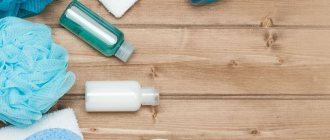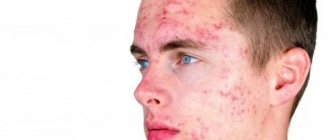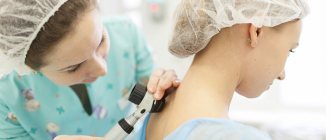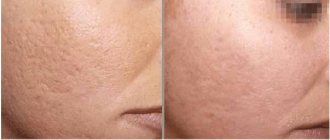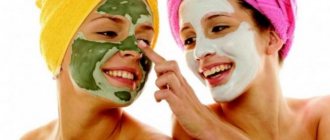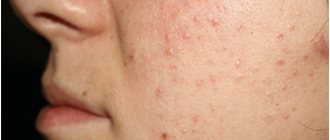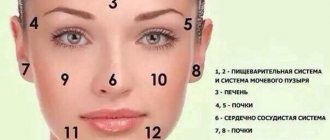Development mechanism
This skin problem occurs due to excessive activity of the sebaceous glands, clogging of their ducts with keratinized cells, which are immediately filled with subcutaneous fat. Such an environment is excellent conditions for the active reproduction of negative pathogenic agents, for example, staphylococcal or streptococcal in nature. Pyoderma is formed - inflammatory manifestations in the upper layers of the skin.
If inflammatory manifestations have not formed, characteristic dark-colored dots are visually visible on the dermis.
Evolution of acne: from comedones to papules and abscesses
Any inflamed bumps on the body are popularly called “pimples” out of habit, but such a term does not exist in medicine. Dermatologists distinguish several elements in the composition of acne or acne. The main ones are comedones, papules and pustules.
Acne or acne is a disease of the sebaceous glands of the skin that occurs mainly between the ages of 10 and 18 years.
Elements of acne:
- A closed comedon is a white pimple without a cavity inside. Under a thin layer of the epidermis, sebum and keratin in the canal of the hair follicle are visible.
- A blackhead or blackhead is an open comedone that forms at the top of a skin pore when sebum oxidizes and becomes contaminated.
- A papule or nodule is a dense red lump with a diameter of about 5 mm.
- A pustule is a yellowish-white dome against the background of a red rim of inflamed skin. Inside there is a cavity filled with purulent contents.
Under the keratin plug, the bacteria Propionibacterium acnes begins to multiply intensively. The immune system enters into an irreconcilable fight against microbes, which is reflected in the development of the inflammatory process. It is associated with pain, redness, moderate or severe itching.
The channel of the sebaceous follicle in the skin is filled with living and dead leukocytes, bacteria, and their toxins. The signs characteristic of inflammation intensify - local tissue swelling, redness, pain. When the process spreads to surrounding tissues, a node or cyst is formed.
Reasons for development
According to dermatological specialists, the most significant reasons for the formation of acne on the face include:
- An increase in the amount of subcutaneous fat due to an uncorrected diet.
- The presence of hormonal “storms” in the human body.
- Neglect of basic personal hygiene procedures.
- Congenital anomalies in the structure of facial pores, the ducts are too narrow and are not able to cope with the load.
- Chronic stressful situations.
- Weakening the parameters of immune individual barriers.
- The presence of other somatic pathologies, for example, in the thyroid organ or nervous tissue.
- Taking hormonal drugs.
- Avitaminosis.
- Use of low-quality cosmetic products.
- External mechanical pressure on the skin, for example, tight hats.
These reasons can only provoke the occurrence of acne. In the absence of conditions favorable for the reproduction of negative agents, such a problem does not bother a person.
Types of acne
Acne can be of several types. Various reasons lead to their formation.
Types of acne:
- Acne vulgaris
- Whiteheads (milia)
- Rosacea (rosacea)
- Blackheads (comedones)
- Steroid acne
- Acne conglobata
- Subcutaneous acne
Acne vulgaris
Most often, acne vulgaris appears during adolescence. As a rule, they go away closer to 20 years of age. Less commonly, acne vulgaris appears in adults. They can be the result of disturbances in the functioning of the digestive system and liver. Sometimes they are caused by endocrine disorders.
At the initial stage of acne formation, the skin becomes covered with small red spots. They open, and in their place a purulent cavity forms. After such acne, scars and cicatrices remain on the dermis, and skin pigmentation changes.
Acne vulgaris appears on the face - this is their favorite location. Sometimes the rash covers the skin of the back and chest.
The main cause of acne vulgaris is hormonal imbalance. Often this problem can be traced among blood relatives, which indicates the influence of heredity. Other causes of acne vulgaris include: errors in nutrition, improper skin hygiene, parasitic damage to the dermis.
Acne vulgaris is mostly a problem among young people. However, it is impossible to exclude their occurrence at 40 or even 60 years of age.
Whiteheads (milia)
Milia are white acne that appears due to overproduction of the sebaceous glands. Whiteheads can develop due to exposure to any traumatic factors on the skin, for example, when it is exposed to excess ultraviolet radiation. Their appearance can also be triggered by internal inflammatory processes occurring in the body.
Whiteheads do not reach large sizes, their average diameter is 2-3 mm. They are quite dense, yellow in color, and resemble grains in appearance. Often such acne appears on the temples, on the nose, on the cheeks, and around the eyes. They can be single or multiple.
A whitehead is essentially a buildup of sebum that sits in a pore and has no way to come out. The head of the eel is white because it shows through the dermis.
Whiteheads often appear due to an unhealthy lifestyle, due to excessive exposure to the sun, when eating salty, fried, smoked and fatty foods.
We cannot exclude such reasons for the development of white acne as: hormonal imbalance, poor skin hygiene, diseases of the digestive system. Many people ignore the appearance of whiteheads by delaying treatment. This should not be done as it may make the problem worse.
Rosacea (rosacea)
Rosacea most often appears on the skin of people who have crossed the age limit of 30 years. They are accompanied by the formation of papules, which subsequently fester. Most often, women suffer from this problem.
Symptoms of rosacea:
- Skin hyperemia. The forehead, nose, cheeks, and chin become red. Acne can spread to the chest and back.
- The appearance of a red rash on the skin. Over time, it transforms into acne.
- Skin thickening. This occurs in the later stages of the disease.
- Vasodilation. The vascular network is visible through the dermis.
- There is a sensation of sand or other foreign body in the eyes. Tearing increases, the whites of the eyes turn red.
The more time a person spends in the sun or in the cold, the worse the skin condition becomes.
Blackheads (comedones)
Blackheads appear on the skin without a preliminary inflammatory reaction. Most often they form on the nose, forehead, chin and cheeks. Rarely, blackheads are found on the back and chest.
The formation of comedones can be triggered by hormonal imbalances, disturbances in the functioning of the ovaries or thyroid gland, and eating fatty or carbohydrate foods.
To deal with the problem, skin cleansing is required. However, this procedure does not last long; it will need to be repeated systematically. With age, the activity of the sebaceous glands decreases, so blackheads rarely appear on the skin.
Steroid acne
These acne look extremely unsightly. This is where their main harm lies. Steroid acne appears on the dermis due to treatment with steroid drugs. Their abolition allows you to cope with rashes. The main problem is that it is not always possible to refuse the drug.
Steroid acne looks like small ulcers that are bright red in color. They can cover the entire body or a specific area of it. Sometimes acne is concentrated only in the area where a person applies the hormonal drug.
Steroid acne can cause a burning sensation and severe itching.
Acne conglobata
These acne are spherical in shape and appear on the arms, legs, neck and back. Acne is located deep in the subcutaneous fat layer of the dermis. Sometimes they cause severe pain and have a blue-purple color. There is a pustule in the center of the blackhead. Conglobate rashes can appear on the cheeks, chest, neck and back. Most often, men suffer from them; age does not matter.
The following disorders can provoke the appearance of conglobate acne:
- Stress, emotional overload, depression.
- Hormonal imbalance, diabetes mellitus, disorders of the endocrine glands.
- Infectious diseases that have a chronic course.
- Excess iodine and bromine in the body.
- Treatment with certain drugs.
- Smoking, external negative factors.
The skin over acne is uneven, and after it heals, scars may remain.
Subcutaneous acne
This type of acne can appear in both adults and teenagers. Subcutaneous acne is formed due to excessive accumulation of pus against the background of inflammation of the sebaceous glands. Most often the back and shoulders, neck, face and chest suffer.
Blackheads are white because there is pus inside them. The eel is surrounded by a red rim. It is represented by an area of inflamed skin.
Causes of subcutaneous acne:
- Hormonal imbalance in the body.
- Immunity disorders.
- Diseases of the digestive system.
- Subcutaneous mite infestation.
- Liver diseases.
- Errors in nutrition.
- Increased sweating.
- Hereditary predisposition.
- Chronic diseases.
When a pimple is located under the skin, it is difficult to squeeze it out. At the same time, a person’s appearance deteriorates significantly, the dermis becomes unattractive. If you try to squeeze out a subcutaneous acne yourself, this can lead to severe skin damage and even blood poisoning. After such manipulations, scars may remain on the face and other parts of the body.
Forms of rashes
The formation of rashes on the skin of the face is not as painful as it is psychologically uncomfortable, because dark spots and inflamed elements, as a rule, do not make anyone look bad. Acne can form in a variety of forms - directly depending on the individual parameters of the human body, the root causes of their formation, as well as a person’s commitment to hygiene procedures.
- Blackheads are the result of incomplete blockage of the gland ducts. Part of the subcutaneous fat manages to reach the surface of the epidermis, where, under the direct influence of melanin, it acquires a dark color. Even in the absence of cosmetic procedures, such a problem can resolve itself - the remnants of accumulated fat will be removed on their own.
- Closed comedones are whiteheads. Caused by intradermal blockage of the sebaceous ducts, as well as their expansion. Visually they appear as lumpy subcutaneous formations with no exit of the duct to the outside. They can form in any age category, in people not only with oily skin, but also with those prone to dryness.
- Rosacea is caused by inflammatory manifestations in them that begin after blockage of the ducts. Papules are raised bumps above the skin level, colored pink or red. Upon palpation, a person notes moderate pain in them. In the absence of specialized help, the negative flora continues to multiply. A purulent focus forms inside the acne - pyoderma.
- Conglobate acne presents an ominous picture; these are lumpy accumulations of formations of different ages, with a red-bluish color and pustular inclusions. They are formed in the deepest elements of the dermis and are also caused by blockage of the sebaceous ducts.
Timely contact with a dermatologist in the first stages of the formation of pathology helps to prevent such severe forms of acne.
Diagnostics
Indurative acne, also called tubercular acne, should be diagnosed by a dermatologist. Moreover, it is advisable to visit a doctor with the appearance of the first such inflammatory bump on the skin.
To clarify the diagnosis, and there can be many types of acne, dermatoscopy may be required. To obtain additional information about damaged and healthy skin, you should undergo skin pH testing.
To prescribe the main treatment, which is antibacterial therapy, the microbe that caused the inflammation is identified. To do this, the contents of one of the eels are collected, and then a bacterial culture is done. The results of this study usually appear at the doctor's office within a week. An antibiotic sensitivity test is also required.
During diagnosis, this type of rash is differentiated from:
- Papulopustular acne.
- Folliculitis.
- Infiltrative-suppurative variant of trichophytosis.
- Streptococcal impetigo.
Treatment tactics
No matter how “elementary” the pathology may seem, the therapeutic tactics of getting rid of acne on the face is a very lengthy and difficult process. As a rule, it takes several weeks, or even months, even using the most modern, innovative developments in the field of dermatology.
How to treat acne in each case is decided by a specialist strictly individually. For the most complete and long-lasting relief from acne, it is necessary to prevent the occurrence of exacerbations and develop a special individual strategy for skin care after completion of treatment procedures.
Severe, advanced versions of acne are treated only under the strict supervision of specialists in beauty salons or medical institutions. In this case, self-medication can only cause irreparable harm.
Currently, comprehensive treatment tactics include:
- Medicinal compositions of hormonal nature.
- Antibiotic therapy.
- Retinoids.
- Medicines that help stop the hyperactivity of the sebaceous glands and help prevent stagnation in them.
- Antibactericidal drugs.
- Immunomodulators and immunostimulants.
- Antimycotics and hormonal drugs may be required.
- Vitamin therapy.
Traditional recipes, after their agreement with a specialist, only complement the basic complex treatment tactics. They can quite effectively speed up the recovery process, helping a person cope with the problem at home.
Clinical picture and classification
Based on the nature of the formations, as well as the severity of the clinical picture, acne is divided into several forms:
- comedonal - many closed acne in the area of the chin and wings of the nose, with no foci of inflammation (pustules);
- papulopustular – there are both closed and open acne, there is a small number of pustules;
- nodular - pustules are present in large numbers all over the face along with open and closed acne;
- severe - extensive inflammation of the skin caused by the fusion of pustules. In this option, scars almost always form at the site of inflammation.
General recommendations
It would seem that it is difficult to get rid of acne; just cleanse the skin and apply ointment. But serious complications can get in the way of such tactics; the human body begins to produce so much subcutaneous fat that the ducts are simply not able to cope with it.
Therefore, the first thing that needs to be done is to reduce the parameters of subcutaneous sebum production. Adjusting the individual diet plays a huge role:
- Eat only natural products, more fiber, cereals, herbs, vegetables, fruits.
- Completely avoid fatty and fried foods, carbonated drinks and preservatives.
- Avoid or limit: fatty foods, flour, as well as sweets and coffee, chocolate.
- Get rid of existing negative habits, for example, smoking, frequent consumption of alcohol.
In second place are individual hygiene procedures:
- Carefully select products for removing decorative cosmetics. If you are prone to acne, it is recommended not to purchase creams, ointments, or masks that contain lanolin or petroleum jelly as one of the components.
- Carry out washing every day - in the morning and also in the evening. Use special modern gels for washing, since the use of soap, especially toilet soap, noticeably dries out the epidermis. The dense stratum corneum further clogs the ducts of the sebaceous glands, aggravating the course of the pathology.
- Use only an individual, absolutely clean, towel for the face area; it should only be used by one person.
- Pillowcases should also be washed more often, especially during the hot season.
- Try not to touch your face during the day, especially with dirty fingers.
- At the initial stages of acne formation, try not to “squeeze” them, as the risk of infection and bacterial agents increases significantly. It is recommended to purchase a special preparation, which, after application, will help activate the regenerative abilities of the dermis. The pimple simply does not have time to form into an acne.
If you act according to a plan developed together with a dermatologist, following the above points, and also avoid chronic stressful situations, try to choose a place of residence away from polluting factors, then relapses of acne will become rare, and the facial skin will delight the owner with radiant beauty.
What to do if acne appears
Acne of any type requires long-term treatment. Sometimes improvement occurs immediately, but more often the skin condition does not change during the first weeks or months. The patient should not take too many medications at once. This can cause dry skin and the body's response in the form of increased sebum production.
If any skin formations appear, an examination by a dermatologist is necessary. This is necessary in order to distinguish acne from other skin diseases, such as:
- folliculitis;
- follicular keratosis;
- milia;
- hyperplasia of the sebaceous glands.
Simple procedures
There are many proven recipes for quickly getting rid of acne in its early stages. For example, rubbing the face with ice cubes prepared from decoctions of medicinal herbs such as chamomile, celandine, calendula, string, aloe juice.
Tea tree and eucalyptus oils also have a pronounced antibacterial effect. It is enough to add a few drops of the product to a decoction for washing or lotion.
Traditional remedies that are necessarily included in treatment tactics include: Zenerit and Baziron. They have antibacterial power, successfully suppressing the proliferation of negative agents on the dermis. There are also a variety of other medications that contain: sulfur, salicylic acid, zinc or silver - they are used after washing to successfully combat pyoderma and acne.
Such products have a side effect - dry skin, but this condition is completely corrected with modern moisturizing creams. If acne recurs more than 4-5 times a year, you should definitely seek advice from a dermatological specialist to determine the root cause.
Prevention of acne on the face in women
In order to avoid the unpleasant consequences of acne, as well as to prevent its reappearance, you must follow the following rules:
- Carefully monitor skin hygiene. This rule especially needs to be remembered by those with oily skin types, since they are most often concerned about the problem of clogged pores. The face should be thoroughly cleansed twice a day, using mild products that do not disturb the water-lipid balance of the skin surface. This is especially true for girls who use cosmetics - it can not only clog pores, but also provoke allergic reactions.
- Change your eating habits. In order to become the owner of beautiful skin, you need to forget about foods such as chips, soda, smoked meats, sausages and sweets. In your menu you need to include as many different plant foods, dairy products, lean meat and poultry, and fish as possible.
- To refuse from bad habits. Alcohol and coffee dry the skin, make it sluggish and flabby, and reduce its protective functions. Smoking causes pores to expand. All these factors certainly will not help in the fight against acne, but will only worsen the situation. Therefore, it is better to give up these habits once and for all.
- Visit your doctor regularly. Most diseases can be cured, while minimizing their consequences, if they are diagnosed in time. The same applies to acne, which is often a side effect of a number of pathologies.
See how to get rid of acne on your back. All about acne vulgaris according to ICD code 10. Find out below.
What are whiteheads? The answer is here.
Only by eliminating the cause of the negative impact of malfunctions of internal organs on the skin can a good effect be achieved in the treatment of rashes on the face.
Cosmetic recommendations
The first aid to acne-strewn skin is to release clogged pores from the yoke of accumulated subcutaneous fat. For this purpose, a variety of exfoliating agents are used, for example, scrubs with solid particles or gel scrubs. Experts recommend using them no more than 1-2 times a week, with great caution - significant mechanical impact can lead to additional skin irritation.
Today, the product line of many well-known brands includes scrubs based on fruit acids with a milder exfoliating effect, suitable for almost all skin types.
Exfoliating masks can have a similar effect; they very effectively help get rid of the keratinized layers of the dermis. Use them 1-2 times a week.
The gentle effects of steam - a kind of “bath” for the face - have also proven themselves excellent since the times of our grandmothers. A handful of medicinal plants, for example, lemon balm or mint, are added to boiling water, and after such a cosmetic procedure, the skin is treated with a drying agent.
Juvenile acne and other forms of acne
White and red papules appear in newborns in the first days of life as a reaction to the mother’s hormones remaining in the tiny body. This type of acne is called “infant acne” and does not require treatment.
The next stage of significant hormonal fluctuations is associated with puberty. In the body of a teenager, the gonads develop, and the ratio of steroid production characteristic of a man or woman is formed.
It is important! The skin is highly susceptible to the influence of sex hormones, especially testosterone, which is produced in both the male and female bodies.
Papulopustular inflammatory acne is most common in the age group from 13 to 25 years, and in women over 30 years of age it occurs in the form of late acne. The appearance of acne in adults is associated with internal diseases, taking medications and dietary supplements, and poor-quality nutrition. Papules and pustules form at any age when exposed to chlorinated water, petroleum products or cosmetics.
How to get rid of acne
Acne treatment should begin with an examination to identify the causes of the problem. You may need to visit an endocrinologist, gastroenterologist; women and girls should consult a gynecologist. They may take blood and urine for a general analysis, blood for biochemistry, hormone tests, stool analysis for dysbacteriosis, and ultrasound diagnostics may be required.
If the rash is mild, then an acne remedy suitable for a specific skin type may be recommended: acne creams, gels, ointments and lotions containing the necessary components to combat comedones, reduce sebum secretion, and eliminate inflammation. These are products containing tretinoin, azelaic acid, benzoyl peroxide.
Moderate and severe degrees are treated with antibiotics; hormones may be prescribed if a hormonal imbalance is detected.
What means to use for treatment:
- Antibiotics. Minolexin is considered the most effective. Available for use in children over 8 years old. It dissolves well in fats, which allows it to act more effectively on the clogged sebaceous gland.
- Sebostatic drugs: Isotretinoin. For severe forms of skin lesions.
- Hormonal therapy. The drug is prescribed by a doctor.
Also, to treat advanced forms, mechanical action on acne is required. All procedures must be performed by a qualified cosmetologist. They cleanse the skin using peelings (removal of the upper layers of skin), facial cleansing, special massage, cryotherapy, and laser therapy.
Important! Proper nutrition plays a big role in getting rid of rashes. It is necessary to exclude fried, smoked, salty, spicy, sweet foods, coffee, and red berries. Add fermented milk products, fruits, rice, lean meats, rice, fish, green and orange vegetables, walnuts, and almonds to your diet.
Home remedies for acne
Skin care is a guarantee of its healthy appearance for many years. A visit to the bathhouse is considered beneficial, as it improves blood circulation and promotes steaming of the skin. You can steam the skin over a saucepan with decoctions for 20 minutes, covered with a towel, and prepare decoctions from coltsfoot flowers, birch leaves and mint.
Apply the following masks to steamed skin:
- Cottage cheese and oats. Oat decoction (1 tbsp.) and 2 tbsp. l. fresh cottage cheese are mixed and applied to the face. You can rest for 20 minutes, then rinse with contrasting water.
- White clay. Take 1 tbsp. l. clay, mix with 2 drops of lemon juice and a few drops of tea tree oil, hold on face for 15 minutes, rinse. Once a week is enough.
- Yeast. Dilute 20 g of yeast with 3% hydrogen peroxide (10 ml), bring to a sour cream consistency. Apply 3 times a week for 20 minutes, course of 20 procedures.
- Honey. Dissolve an aspirin tablet in 1 tsp. water, mix with 2 tbsp. l. honey, keep on face for 15 minutes.
A timely visit to the doctor will help you avoid serious problems with the skin of the face and body. A competent approach to your external and internal state will prolong your beauty and youth, give you a good look, and save you from many problems.
